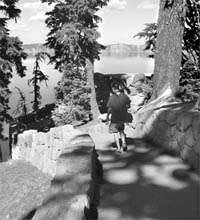Sinnott Memorial Overlook: new exhibit provides answers to lake’s geologic history
Herald and News
Klamath Falls, Oregon
September 02, 2003
Smarter visitors ask smarter questions.
Thanks to a dazzling new exhibit a the Sinnott Memorial Overlook, the open parapet built in 1930 high on the caldera wall above Crater Lake, visitors to Crater Lake National Park are better understanding the park’s geological history.
 |
| A stone walkway from the Rim Visitor Center leads to the Sinnott Memorial, which was opened in 1930. |
“It does seem like people are getting a lot out of the exhibits and asking more intelligent questions,” says Dave Grimes, a seasonal park ranger.
He and other rangers give 20-minute programs on “Discovering Crater Lake” at 11 a.m., 1, 2 and 3 p.m. daily, but only through Monday. Until late September, when the overlook will close, talks will be given intermittently.
“I can tell people have been reading the exhibits and watching the video because they know the answers to my questions,” says Grimes. “We can go further into depth in our interpretive programs because the people are smarter.”
Making people smarter is a short video. It shows the growth of Mount Mazama, the composite volcano that spent several million years building to a height of about 12,000 feet, and its collapse, which lasted only a few days. Left behind was the caldera that, as the video shows, filled with water to create what is now Crater Lake.
“We get a ton of visitors comments about that from visitors wondering if they can buy a copy of the video or use it for school groups,” says Martha Hess, who helps oversee the park’s interpretive programs.
In a room packed with descriptive, easy-to-under exhibits and displays, the video is the centerpiece. Within a few minutes, and without spoken words, it visually exhibits the processes that created Mazama and, even more impressively, illustrates why and how the mountain collapsed.
“People are glued to that,” says Grimes of the video.
The Sinnott exhibit, which cost $425,000, opened late last August during the park’s centennial celebration. Its late opening date limited the number of visitors because the overlook closes in late summer or early fall.
Its semi-obscure location – a paved walkway behind the Rim Village Visitor Center climbs down to the Sinnott – also means it’s unintentionally overlooked by visitors.
For years the back room that houses the exhibits was poorly lighted and offered unexceptional displays before being closed. For most visitors, the Sinnott was no more than a roofed, open-fronted room that offered a stunning, broad-sweeping, unobstructed view of the lake.
That view of the lake is still awe inspiring, and the geology video and other exhibits provide a basis of knowledge that help extend that sense of wonder.
Personally, despite more than 30 years of discussing, extensively exploring and writing about Crater Lake, my understanding of the eruptive process was multiplied googolplex after viewing the video.
The Sinnott Memorial is open 9:30 a.m. to 5 p.m. daily. With summer nearing its end, and the hours, time is getting short. Closing time is tough on visitors who haven’t finished eyeballing the displays, and the ranger who has to turn them away.
As Grimes admits, “My heart breaks because there’s always 10 or 15 people down there at 5 o’clock when I have to lock the doors.”
A stone walkway from the Rim Visitor Center leads to the Sinnott Memorial, which was opened in 1930.
***previous*** — ***next***

